The Holy Land & Petra
The Tour Itinerary:
After an early morning Mass at the Church of the Holy Sepulcher we will return to our hotel for breakfast. We will then depart Jerusalem and drive to the Allenby Bridge to cross into the Hashemite Kingdom of Jordan. Once in Jordan we will visit the traditional Baptismal Site on the River Jordan and view Elijah’s Hill, the place from which the great prophet went up into the sky in a fiery chariot. Following that we will travel south to Mt. Nebo where Moses viewed the Promised Land. The highlight of our day will be the descent into magnificent Petra, one of the Seven Wonders of the World.
The early morning Mass described in the itinerary was certainly early: 6:00am. The Franciscans are allowed to use a chapel that is situated next to the very top of Golgotha from 5:00am to 8:00am each day. This was the only slot today that was available to our group. We got a wake up call at 4:30 and boarded the bus at 5:00. (Side note: We got wake up calls every day during our tour.) We got to the Church of the Holy Sepulcher around 5:30 and were able to easily walk through the building since there were so few tourists around. We made our way to the topmost chapel, owned by the Greek Orthodox, which is
Day Seven: Jerusalem to Jordan & Petra
November 13, 2016
|
Sunday, November 13
The Tour Itinerary:
After an early morning Mass at the Church of the Holy Sepulcher we will return to our hotel for breakfast. We will then depart Jerusalem and drive to the Allenby Bridge to cross into the Hashemite Kingdom of Jordan. Once in Jordan we will visit the traditional Baptismal Site on the River Jordan and view Elijah’s Hill, the place from which the great prophet went up into the sky in a fiery chariot. Following that we will travel south to Mt. Nebo where Moses viewed the Promised Land. The highlight of our day will be the descent into magnificent Petra, one of the Seven Wonders of the World.
The early morning Mass described in the itinerary was certainly early: 6:00am. The Franciscans are allowed to use a chapel that is situated next to the very top of Golgotha from 5:00am to 8:00am each day. This was the only slot today that was available to our group. We got a wake up call at 4:30 and boarded the bus at 5:00. (Side note: We got wake up calls every day during our tour.) We got to the Church of the Holy Sepulcher around 5:30 and were able to easily walk through the building since there were so few tourists around. We made our way to the topmost chapel, owned by the Greek Orthodox, which is
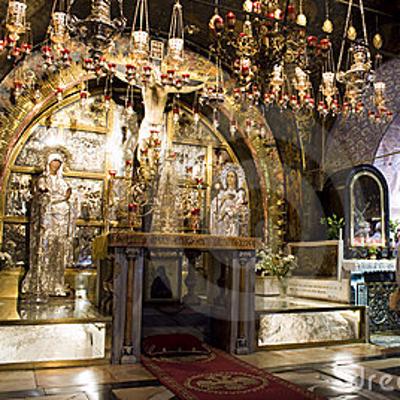
built over the very top of Golgotha. This is the chapel that we bypassed yesterday (picture on previous page). There is an altar above the hill with a little hole in the floor beneath the altar. The hole is above the recess where the cross was inserted. As is customary for pilgrims, members of our group went up singly to kneel before the altar, put their heads underneath and kiss something. When I had my turn, I wasn't sure what people were kissing so I kissed the empty space.
The Masses in the chapel we were in are limited to 30 minutes and there is to be no singing and no homily. Fr. Jim did the Mass in 20 minutes. During Mass we could here chanting in another part of the church which was very uplifting. During Mass and even now as I write this, I am in awe of where I was: The place where Jesus suffered and died to absolve me and all humanity from our sins. This was for me the most memorable and beautiful of all the places we visited.
We returned to our hotel, had breakfast (I had a decent size breakfast since my stomach was feeling ok) and departed for Jordan at 8:30. After clearing the suburbs of Jerusalem, we motored through barren wasteland until we reached the Israeli side of the Israel/Jordan
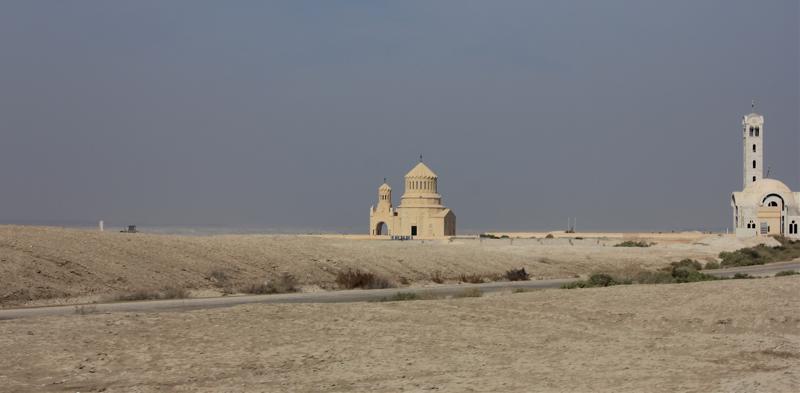
border. After Rami left the bus to advise the Israeli authorities that we were going into Jordan, we all disembarked. Our bags were unloaded, and we walked to a Jordanian checkpoint to have our passports reviewed. Since Rami is not authorized to be a guide in Jordan, he left us at this time. A new bus came up, and our bags were loaded on it. We proceeded for perhaps a mile through a no-man's land which acts as a buffer zone between Israel and Jordan. We past a Jordanian outpost and then went another quarter mile to a building labelled "Welcome Office". Our new guide, Emad Ziadat like Rami an Arab Christian, took all of our passports away for maybe 25 minutes for, presumably, detailed checking. We finally got into Jordan proper about 11:00. It took close to two hours to go from Israel to Jordan.
Emad formally introduced himself and outlined our travel plans for the day. Our first stop was the site where John baptized Jesus at the River Jordan. Evidence of shrines at this site date from the 2nd century so the site is deemed to be pretty accurate. It has only been since 1999 that Jordan has allowed access to the area. In the general area, there are at least a half dozen churches representing various Christian denominations either completed or under construction. A picture of a Greek Orthodox church which we saw as we got close to our drop off point is on the prior page.
On our walk from where we parked, we came to a spot where
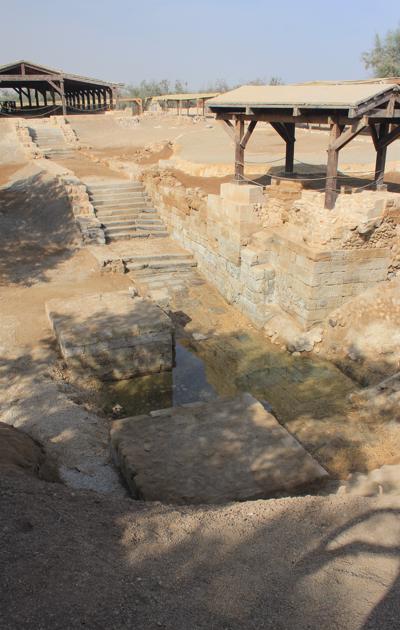
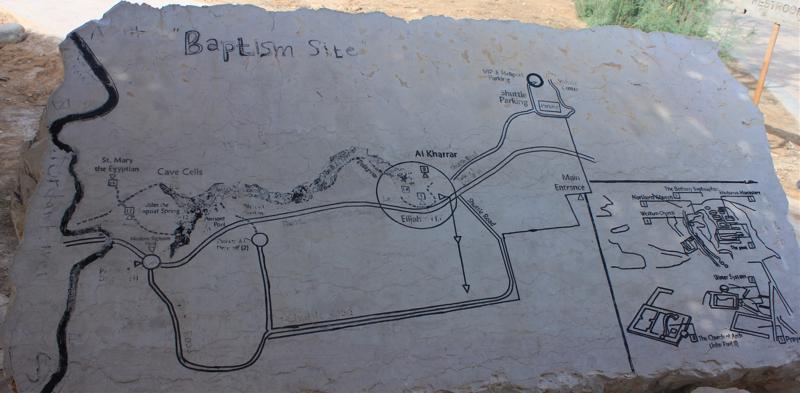
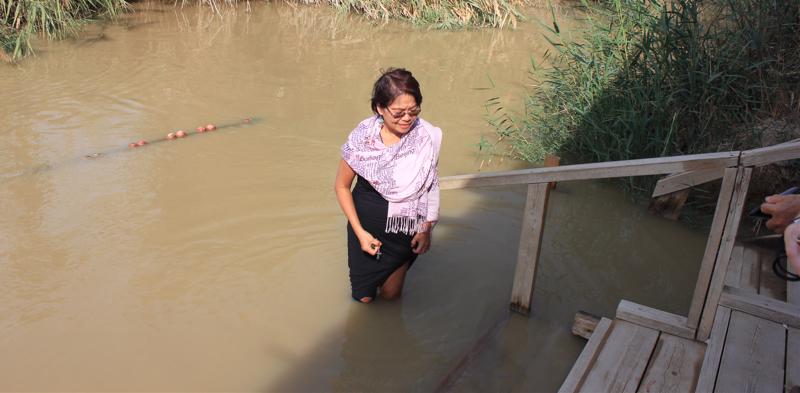

a stairway ran down to a little pool fed by water from the River Jordan. This is used occasionally as a baptismal place (picture on page 38). We walked on and came to the river about a half mile from where our bus driver let us off. The river at that point is not more than 50 yards wide, if that, and appears to be pretty shallow. It also is about a quarter mile from its course at the time of Christ. There is a small wooden staircase that allows people to go into the water, and a few of our party did that (see middle picture on page 39 of Phuong Trinh in the water). It is a simple site. In order to diminish Jordan's ability to attract tourists, Israel built a sizable pavilion with concrete stairs going down into the water directly across from where Jordan put its site (bottom picture on page 39). True to the Israeli's intent, there were many more people on the Israeli side. The site where we were includes well-excavated ruins of three churches that were built in the 5th and 6th centuries.
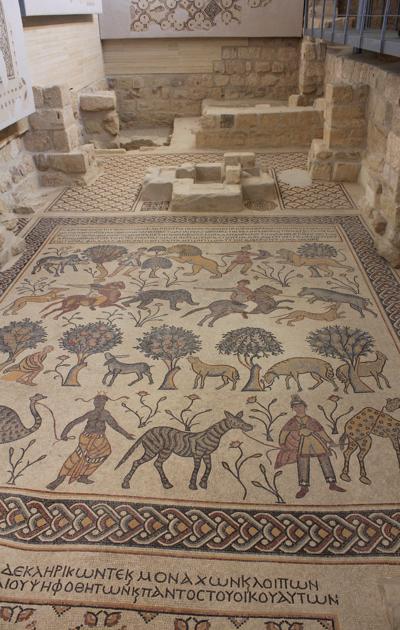

We lunched at a small cafe which was not particularity good then motored to Mount Nebo where Moses saw the Promised Land on the other side of the River Jordan. There are ruins of structures from past centuries (below), and the Franciscans have a shrine atop the mountain. Interestingly, the major part of the building with the shrine has well preserved mosaic tile floors that date from the Byzantine era in 5th and 6th centuries (at right on the adjacent page). As Mount Nebo was the highest spot around, the views could have been very good. It was, however, a hazy day so the views were diminished.
We left Mount Nebo about 3:00 and arrived at Petra around 7:00 with two short stops along the way. The part of Jordan through which we drove is barren desert. Some deserts can be pretty. This one was not. We did see a few Bedouin encampments along the way. A picture

one such encampment is above.
The Marriott where we stayed was similar to other Marriotts in which I stayed. Dinner was once again a buffet with lots of healthy vegetable dishes. Sadly, I am not a healthy vegetable sort of guy, but I managed to find something sort of bad that I could eat.
Accommodations: Petra Marriott Hotel
> Queen Rania Al Abdallah Street, Petra, Jordan
> Phone: ++962-3-2156407
> Highly rated, free WiFi

1.
Day One: Depart the USA
2.
Day Two: Arrive Tel Aviv & Bethlehem
3.
Day Three: Jerusalem
4.
Day Four: Places Near Bethlehem
5.
Day Five: Bethlehem
6.
Day Six: Jerusalem Again
7.
Day Seven: Jerusalem to Jordan & Petra
8.
Day Eight: Petra & Amman
9.
Day Nine: Amman to the Sea of Galilee
10.
Day Ten: Galilee
11.
Day Eleven: Tiberias to Tel Aviv
12.
Day Twelve: Return Home
13.
Post-Trip Reflections
Share your travel adventures like this!
Create your own travel blog in one step
Share with friends and family to follow your journey
Easy set up, no technical knowledge needed and unlimited storage!